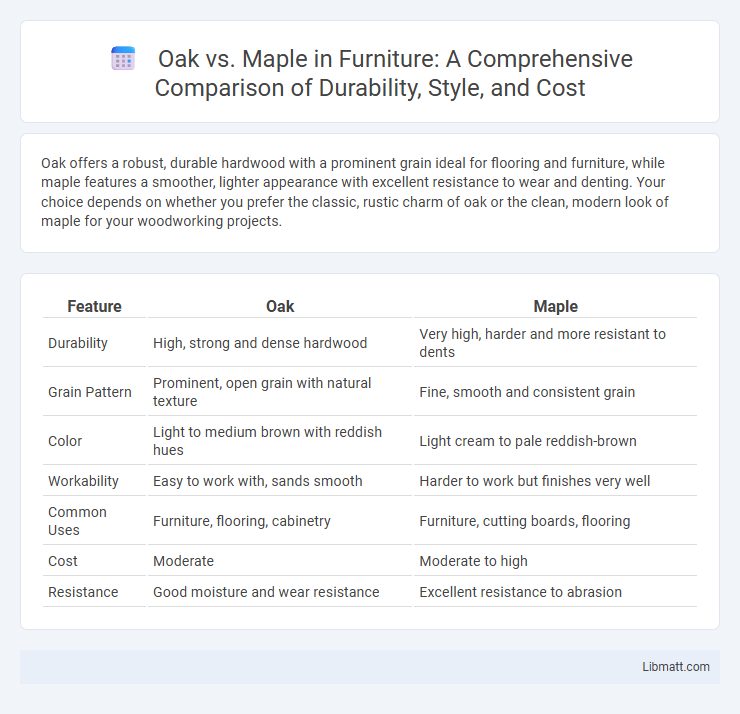Oak offers a robust, durable hardwood with a prominent grain ideal for flooring and furniture, while maple features a smoother, lighter appearance with excellent resistance to wear and denting. Your choice depends on whether you prefer the classic, rustic charm of oak or the clean, modern look of maple for your woodworking projects.
Table of Comparison
| Feature | Oak | Maple |
|---|---|---|
| Durability | High, strong and dense hardwood | Very high, harder and more resistant to dents |
| Grain Pattern | Prominent, open grain with natural texture | Fine, smooth and consistent grain |
| Color | Light to medium brown with reddish hues | Light cream to pale reddish-brown |
| Workability | Easy to work with, sands smooth | Harder to work but finishes very well |
| Common Uses | Furniture, flooring, cabinetry | Furniture, cutting boards, flooring |
| Cost | Moderate | Moderate to high |
| Resistance | Good moisture and wear resistance | Excellent resistance to abrasion |
Introduction to Oak vs Maple
Oak and maple are two popular hardwood species widely used in furniture, flooring, and cabinetry due to their durability and attractive grain patterns. Oak wood features a prominent grain with a coarse texture, offering excellent strength and natural resistance to wear, while maple is known for its fine, consistent grain and lighter color, providing a smooth finish and durability. Both woods vary significantly in hardness, with oak generally ranking higher on the Janka hardness scale, affecting choice based on project requirements and aesthetic preferences.
Key Differences Between Oak and Maple
Oak features a coarse texture with prominent grain patterns, making it visually robust, while maple has a fine, uniform grain that offers a smoother appearance. Oak is generally harder and more durable, scoring around 1360 on the Janka hardness scale compared to maple's 1450, though maple tends to resist wear better due to its tighter grain. In terms of color, oak ranges from light tan to reddish-brown, whereas maple is typically lighter, with pale cream or light reddish hues.
Appearance and Grain Patterns
Oak displays a coarse, prominent grain pattern with open pores creating a textured surface often featuring cathedrals and rays, offering a rustic and traditional look. Maple is characterized by a smooth, fine, and consistent grain with subtle, wavy patterns and occasional birdseye or curly figure variations, lending itself to a clean, modern aesthetic. The natural color of oak ranges from light tan to medium brown, whereas maple typically exhibits a creamy white to light reddish-brown hue, influencing the overall warmth and mood of a space.
Durability and Hardness Comparison
Oak is renowned for its exceptional durability and hardness, with a Janka hardness rating of approximately 1,290 to 1,360, making it highly resistant to dents and scratches. Maple, particularly hard maple, surpasses oak in hardness with a Janka rating of about 1,450, offering superior strength and longevity for high-traffic areas. Choosing between oak and maple depends on your specific needs for durability, with maple providing slightly better resistance to wear and tear while oak offers a classic, sturdy option.
Color Variations in Oak and Maple
Oak wood displays rich color variations ranging from light tan to deep reddish-brown, often with prominent grain patterns that add character to furniture and flooring. Maple, by contrast, typically offers a lighter, more uniform color palette, featuring creamy white to light golden hues that brighten interior spaces. You can choose oak for warmth and texture or maple for a sleek, contemporary look based on your design preferences.
Common Uses in Furniture and Flooring
Oak and maple are popular choices in furniture and flooring due to their durability and attractive grain patterns. Oak's strong, coarse texture makes it ideal for heavy-use furniture and traditional hardwood flooring, while maple's fine, uniform grain is favored for contemporary furniture designs and smooth, light-colored flooring. Your choice depends on the desired style and wear resistance, with oak providing a classic, rustic look and maple offering a sleek, modern finish.
Maintenance and Care for Each Wood Type
Oak requires regular cleaning with a damp cloth and occasional application of wood polish to maintain its durability and rich grain, while avoiding excessive moisture prevents warping. Maple demands more frequent upkeep due to its finer grain, including gentle cleaning with mild soap and water, and periodic sealing to protect against scratches and stains. Both hardwoods benefit from prompt spill cleanup and avoidance of direct sunlight to preserve their natural beauty and extend longevity.
Price and Availability
Oak wood generally commands a higher price than maple due to its durability and widespread demand in furniture and flooring markets. Maple is more affordable and often more readily available, especially in North America, where it grows abundantly. Both woods are commonly stocked by lumber suppliers, but regional availability may affect pricing and accessibility.
Sustainability and Environmental Impact
Oak trees, known for their slow growth and dense wood, contribute to long-term carbon sequestration, making them a sustainable choice for timber when responsibly harvested. Maple trees grow faster and can be sustainably managed with shorter rotation periods, reducing deforestation pressures but may store less carbon over time compared to oak. Choosing wood from certified sustainable sources ensures your environmental impact is minimized, supporting forest ecosystems and biodiversity.
Choosing the Right Wood: Oak or Maple?
Oak offers exceptional durability and a prominent grain pattern, making it ideal for heavy-use furniture and flooring, while maple provides a smoother, lighter finish with fine grain suited for modern aesthetics and detailed woodworking. Oak is typically harder and more resistant to wear, with a natural warmth that complements rustic or traditional designs, whereas maple's uniform texture enhances stain absorption, allowing for versatile finishing options. Selecting between oak and maple depends on the desired strength, appearance, and finish compatibility for your specific woodworking project.
oak vs maple Infographic

 libmatt.com
libmatt.com